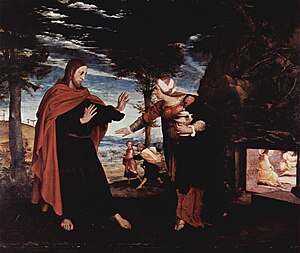
The Protestant Reformation during the 16th century in Europe almost entirely rejected the existing tradition of Catholic art, and very often destroyed as much of it as it could reach. A new artistic tradition developed, producing far smaller quantities of art that followed Protestant agendas and diverged drastically from the southern European tradition and the humanist art produced during the High Renaissance. The Lutheran churches, as they developed, accepted a limited role for larger works of art in churches,[1][2] and also encouraged prints and book illustrations. Calvinists remained steadfastly opposed to art in churches, and suspicious of small printed images of religious subjects, though generally fully accepting secular images in their homes.
In turn, the Catholic Counter-Reformation both reacted against and responded to Protestant criticisms of art in Roman Catholicism to produce a more stringent style of Catholic art. Protestant religious art both embraced Protestant values and assisted in the proliferation of Protestantism, but the amount of religious art produced in Protestant countries was hugely reduced. Artists in Protestant countries diversified into secular forms of art like history painting, landscape painting, portrait painting and still life.